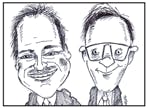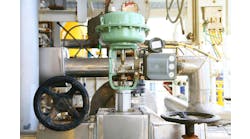This article was printed in CONTROL's December 2009 edition.
Greg McMillan and Stan Weiner bring their wits and more than 66 years of process control experience to bear on your questions, comments, and problems. Write to them at [email protected].
Greg: Scientific and engineering feats are greatest when the inner geek is at its peak. We can hope that company executives are fans of the The Big Bang Theory TV show or avid readers of our insightful books, such as Logical Thoughts at 4:00 a.m., and want us around for the entertainment value. Given a noticeable lack of sense of humor in management, we may need to show the monetary benefits of projects as much as the technical achievements.
Stan: We would not have survived to write books making fun of corporate life if our technical and monetary achievements were in the noise band. Even if you don't "push the limits of humor," you need to make your contribution to the company's fiscal success recognizable.
Greg: Twenty-first-century automation systems have an incredible amount of untapped capability and flexibility. They can mimic the best practices of the best operators in terms of recipes and sequences to handle special situations, including startup and product grade transitions. The repeatability of automated recipes and sequences facilitates the optimization of plant operation.
Stan: Each operator has their own idea of what is best. "Free will" implies human responses are unpredictable. As a result, eliminating the uncertainty introduced by the ever-changing variety of human responses enables more effective identification and analysis of abnormal events and disturbances visually through pattern recognition and automatically through data analytics.
Greg: Once uncertainty and variability have been reduced, setpoints can be moved to more efficient or productive operating points. The sign on the configuration room door, "Geeks Rule," can become a statement of reality rather than just an expression of geek pride.
Stan: Plant rangeability (the ratio of maximum to minimum controllable production rate) can be maximized allowing the plant to respond to high and low market demands. In the July column, "Downturn Turndown," we talked about the importance of control valves and flow measurements for achieving the increased rangeability of plant operations needed today.
Greg: Examples drive these points home as fast as Stan's cars over the years. We go for the finish line of our series on "Show Me the Money" (Part 1 appeared last month) with more case histories from Michel Ruel, president of Top Control (www.topcontrol.com).
Michel: Operations managers at a nickel-processing plant did not believe in process control. In their opinion, their plant could be run only in manual mode. Most loops were in manual. Each operator had his own recipe. The plant had to process all material coming from the mine, and could not be stopped even for maintenance, since actual capacity barely met production needs. The cost of plant downtime was $1,000 per minute, so any optimization must not require or cause a plant shutdown. So, the control strategies were validated and redesigned. Proper and effective equipment selection and operation (transmitters, valves and actuators) were verified. Loops were tuned and control strategies were optimized, including the addition of fuzzy logic to push the ball mill at its limits. Operations, process metallurgists, maintenance and engineering were involved. Recurrent benefits of $7 million per year were achieved. Now the plant can be stopped since the yield has increased and the plant capacity is now above mine tonnage. Many loops have been added since operations now seeks to automate more of the operator actions.
Greg: The second case history involves a cogeneration plant (biomass) in a pulp mill.
Michel: The power plant on the grid generated power sold to the grid burning biomass and chemicals. The steam exhausted by the turbines was used in the plant. During high production, the plant was not self-sufficient, and bought electricity from the grid. The contract at peak hours had high penalties. The biomass boiler also burned oil. Depending on conditions, it could be better to use oil burners. Two alternatives were presented—advanced model predictive control and enhanced basic control using standard DCS functionality. The DCS approach was chosen for understandability and maintainability by plant personnel. All loops were optimized based on the goal, and if the goal varied depending on conditions, tuning parameters based on new specific conditions were used. Real- time control strategies were developed to adjust operation and selection based on cost, contract, production and operation requirements. Real-time control strategies were designed to mimic the best-operator approach to handle special events or disturbances. The DCS adjusted production rate for both turbines, decided which fuel was be used, adjusted the amount of steam temporarily vented, and managed transitions without intervention from operations. The results were a drastic reduction in steam vented, no penalty during peak hours and a reduction in oil consumption. Plant personnel were trained to modify the system when contract and cost structure varied. Recurrent benefits are estimated to be $2 million per year, with less than a month payback for the process control improvement.
Stan: The last story is that of a chemical plant with a common situation and opportunity in many plants pushed beyond their nameplate capacity.
Michel: Mechanical failure was high as the plant pushed their equipment to its limits to maximize production. The plant manager asked to "balance" production versus mechanical repair costs. The cost of breakdowns was high. The mechanical engineer calculated limits for each piece of equipment. The electrical engineer converted mechanical limits in electrical values (maximum current, maximum power, maximum frequency on variable speed drives). Constraint control via override PID loops was used to adjust feed rate. Any equipment reaching its limits reduced the feed rate. No instrumentation was added; information from the motor control system was sufficient. Each constraint was adjustable. A dashboard indicated which constraint was limiting feed rate (hours and percent). The dashboard has been used to decide how to de-bottleneck the plant. The results were a drastic reduction in breakdowns, a reduced mechanical maintenance budget, an increase in equipment reliability, and a maximization of production and equipment run time. Payback was less than a month.
Greg: For some comic relief, I turned to a long-time friend, Stephen Sanders, who I thought was the "Robin Williams" of Engineering Technology at Monsanto. Steve, with a lot of help from his sons Corey and Jason, came up with 22 signs you are a geek. Control's managing editor, Nancy Bartels, contributed a couple to make the list a memorable 24 to help, as Jason says, "embrace your inner geek." This month, we'll share the first dozen.
"You Know You're a Geek If…"
24. You didn't realize a mouse was also a type of animal;
23.You don't think "reverse polish notation" is the punch line of a joke;
22. You think jokes involving 5¼-in. floppy disks are funny;
21. You answer the question, "Can you bring a graphing calculator?" with another question, "Which one?"
20. You use words like "heuristic," "NP-Hard" or "travelling salesperson" in daily conversation;
19. You have a tattoo on your bicep of a motherboard in a heart;
18. You spend Saturday night watching the progress of your registry scan;
17. "Integration" makes you think of "Riemann sum" before "civil rights";
16. Your browser's home page is TigerDirect.com;
15. You buy a new hard drive for every important computer file "to make sure you can find it later";
14. You believe Mt. Rushmore should add Alan Turing, Alonzo Church or both; and
13. You own any dice that don't have six sides.







